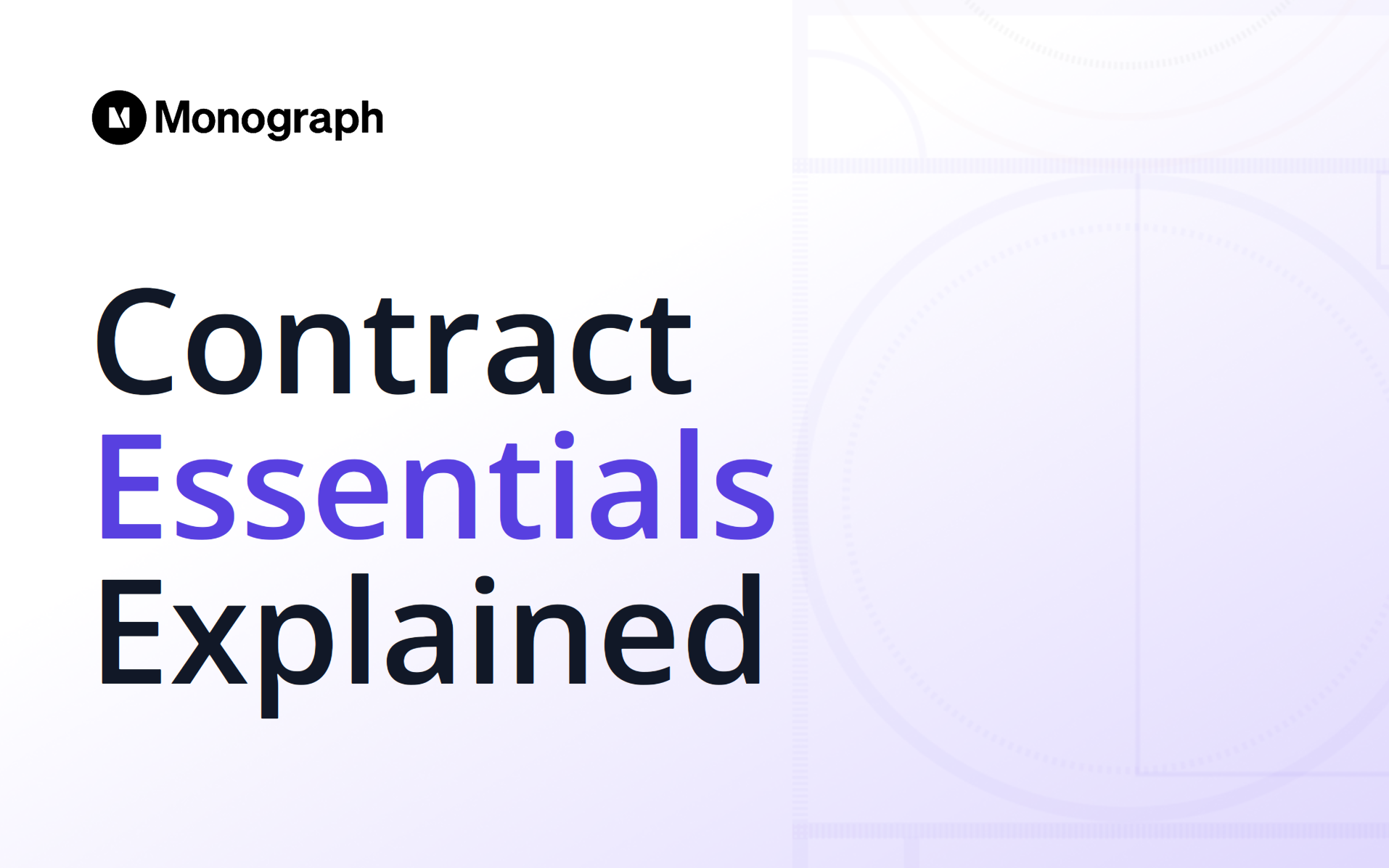Contents
If you've ever wondered where the profit went on an otherwise well-run project, look to the contracts. Poor contract management quietly drains 2–11% of revenue and erodes as much as 15% of a contract's potential value. Nearly half of contract professionals admit they fight constant delays and inefficiencies when collaborating on terms and approvals. Those percentages translate into real dollars you could be putting toward better tools, talent, or the next big bid.
I've seen talented engineers stumble not on technical design but on the fine print that governs scope, fees, and risk. The same rigor you apply to load calculations or system performance works for contracting. You already understand precision and systematic thinking: you just need to apply it to agreements.
The five steps ahead work for mid-level engineers and architects juggling complex projects: lock down scope, choose the right pricing model, negotiate protective clauses, track performance in real time, and handle changes without derailing the schedule. Master these moves and you'll deliver clearer agreements, tighter risk control, and healthier margins before the first line is drawn.
Check out our latest insights on the Monograph blog for more proven strategies from successful A&E firms.
Quick-Start Contracting Blueprint
These five moves protect your projects and improve your firm's bottom line without drowning in paperwork or legal jargon:
- Define scope with absolute clarity so surprises and scope creep never derail your schedule.
- Select the optimal pricing structure to place risk where it belongs, not on your balance sheet.
- Negotiate key clauses that shield your team while keeping client relationships intact.
- Implement robust tracking systems that flag budget, schedule, and quality drift before it turns costly.
- Establish clear processes for changes and disputes so issues resolve in days, not months.
Firms that get these foundations right see measurable improvements in project delivery and cash flow. With this approach, you'll turn agreement management from a source of revenue leakage into a competitive advantage on your very next project.
Real firms using these principles report 25% profit growth and 50% efficiency gains within months of implementation.
Step 1 – Scope & Deliverables: Define the Work
You rarely lose money because your engineers mis-size a beam; projects bleed when no one agrees on what the beam is supposed to support. Scope creep can wipe out significant project value, all because the contract never nailed down the details in writing.
"Defining the services provided to avoid ambiguity is the foundation of successful engineering contracts." That sentence belongs on every drawing sheet, yet too many scopes remain fuzzy paragraphs buried in email threads. Before you issue a single RFI, pin down five essentials:
- Tasks and outcomes: Spell out each service (calculations, BIM models, field reports) and how you measure completion
- Explicit exclusions: State what you won't do as clearly as what you will; ambiguity invites unfunded expectations
- Milestones and deadlines: Tie dates to objective conditions: "geotechnical report delivered" beats "around early fall"
- Deliverable standards: List formats, codes, or ASTM references so no one debates "draft" versus "issue for construction"
- Approval cadence: Define who signs off, in what timeframe, and what silence means (approval or hold)
Get signatures on a written agreement before anyone opens CAD. When scope shifts, and it will, document the change order with pricing and schedule impacts before proceeding. That habit turns scope creep into scoped revenue.
Load your approved scope directly into Monograph's project tracking system. Our signature MoneyGantt™ feature tracks hours and dollars against every line item in real time, so you and the client see the moment a phase edges toward over-burn. Accountability shifts from "trust me" to data both sides can act on before costs snowball.
Want to see how other firms have transformed their contract management? Explore real success stories from A&E professionals who've implemented these strategies.
Step 2 – Pricing & Contract Type: Pick the Right Fit
Your fee structure determines who eats the overruns. Choose wrong and you'll either price yourself out of work or watch your profit disappear into scope creep that wasn't your fault.
Contract engineers in the U.S. typically charge $30–$60 per hour, but rates vary with specialization, region, and project complexity. Architects and engineers both face similar pricing pressures: the key is factoring in hours, risk premium, and overhead before locking yourself in.
Run these numbers and you'll see how a modest productivity slip erases your margin under fixed-price, while the same slip on T&M transfers cost to the owner. MoneyGantt™ makes this transparent by mapping your hours and their dollar burn against any agreement model in real time, flagging trouble before you're upside-down.
The right pricing structure aligns incentives so both parties stay focused on delivering quality work without surprise invoices or frantic value-engineering sessions.
Step 3 – Negotiation & Risk Allocation
Start every negotiation at the point where the work is defined. When your scope is airtight, you can focus on risk allocation instead of fighting over what you're actually delivering. Walk the client through the deliverables first, then address the clauses that determine who carries which risks.
Standard of Care sets the performance bar. Keep it aligned with "industry-accepted professional standards," not perfection. Indemnification comes next. Your goal is simple: confine it to damages arising from your own negligence or willful misconduct, nothing more. Professional bodies and model contracts consistently show that unlimited indemnity contradicts engineering and architectural norms.
Limitation of Liability is your financial firewall. Cap it at the lesser of your fee or your professional-liability insurance limits. Add a mutual waiver of consequential damages so neither party faces open-ended exposure. Research on negotiation strategies suggests bundling these clauses—offer a modest indemnity concession in exchange for a firm liability cap—to reach agreement faster.
Termination language completes your risk protection. The agreement must entitle you to payment for work performed plus reasonable demobilization costs if the client terminates early.
Here's the pushback script that works:
"While we stand behind our work, unlimited indemnity exceeds our insurance coverage and creates uninsurable risk. We propose limiting indemnity to damages caused by our negligence, capped at our fee or insurance limits."
The tone matters: collaborative, factual, and anchored to insurable reality. Apply this same mindset to fee negotiations. Explain why qualifications-based selection delivers better outcomes than lowest-bid races.
Monograph's comprehensive platform tracks caps, waivers, and indemnity limits across every project, so you never accept terms that exceed your coverage. When you see the numbers in one place, risky clauses stop slipping through.
Step 4 – Project Controls & Tracking
Once you sign the agreement, those promises can unravel fast if you're not watching the numbers. The fix is straightforward: track everything in real time and blend schedule, cost, and scope into one clear picture.
Start with cost. Track your Cost Performance Index (CPI) every week: CPI > 1 means you're earning more value than you're spending, while anything below signals trouble. Pair it with the Schedule Performance Index (SPI) to catch timing issues early. When SPI > 1, you're ahead of schedule. Drop below one and you know crew coordination needs attention. Add a running budget-vs-actual snapshot so you spot overruns before they hit accounting.
Numbers don't save projects; rhythm does. Hold a fifteen-minute budget check every Friday, schedule reviews tied to client meetings, and scan for change orders whenever new requests land. This keeps everyone looking at the same dashboard instead of scattered spreadsheets.
Focus on leading indicators, not just historical data. Team utilization rates show whether you're burning expensive staff on cheap tasks. A live change-order log tracks cumulative hits to scope and fee. Keep phase variance within reasonable limits at key checkpoints: exceeding typical benchmarks can make profitability much harder to recover.
This vigilance sounds exhausting until you automate it. MoneyGantt™ pulls time entries, invoices, and task progress into one visual bar: green when you're on track, yellow when you're creeping, red when things are falling apart. The chart updates every time someone logs an hour, giving you warnings days or weeks before spreadsheets would catch the same trend. Combined with proven project management KPIs, that visibility turns risk management from reactive firefighting into smart course correction.
Project controls aren't bureaucracy; they're the structural system holding your budget, schedule, and scope together. Get the metrics and cadence right, and you'll finish jobs with margin left to design something remarkable on the next one.
Engineering and architecture firms implementing these controls report 25% less budget overages and 2x faster billing processes. Learn more about Monograph's comprehensive benefits for engineering and architecture firms looking to gain better project control.
Step 5 – Change Management & Dispute Resolution
Change happens on every project, but unmanaged change kills profitability. Every undocumented scope adjustment compounds losses before you realize what's happening. A clear, upfront process keeps surprises from eating your fee.
First, establish a three-step change-order routine:
- Identify the requested change and map its impact on schedule, budget, and downstream deliverables.
- Price the modification with backup: labor hours, unit costs, mark-ups so both parties see the math.
- Authorize in writing before anyone starts work. No signature, no work.
Build in two protections for every change: a mutual waiver of consequential damages and a pre-selected dispute path. Both clauses prevent you from paying for losses you can't control and stop disagreements from dragging out in court.
When conflicts surface, the resolution method you agreed to at signing determines how painful the fix becomes:
Mediation's speed and low overhead make it the go-to for most engineering and architectural changes. Parties often settle within a week, while arbitration cases regularly stretch to the one-year mark and beyond, piling on fees along the way.
For example, imagine a mid-sized utilities upgrade facing a late-stage $20k scope addition. A one-day mediation could reach agreement on price and schedule relief quickly, keeping the project moving. Defaulting to arbitration might leave the site idle for weeks: an illustrative scenario showing why dispute path matters.
Monograph keeps that paper trail airtight. MoneyGantt™ logs every approved change, updates the fee curve in real time, and stamps each revision with who signed and when. Your audit trail lives in the same view as your budget, so you spot scope creep before it erodes your margin.
For more insights on managing project changes effectively, check out the latest articles on our blog and see how other firms are handling similar challenges in our success stories collection.
Regulatory & Compliance Essentials
Think of the agreement like a structural column: if you miss a single code requirement, the whole project can crumble. Before you sign, run through these compliance checkpoints.
State procurement rules govern every aspect of public A&E work, from bidding procedures to disclosure requirements and bonding. Missing a single filing can delay projects for weeks or disqualify your firm entirely. Know the statutes in your jurisdiction and build compliance into your proposal timeline.
Professional licensing verification protects both your firm and your ability to get paid. Every architect, engineer, and consultant needs an active license in the project's jurisdiction, plus current corporate registrations. A suspended license voids your agreement and your invoices. Check expiration dates when you check project deadlines.
Insurance certificates must meet or exceed minimum requirements for professional liability, general liability, and workers' compensation. Track expiration dates in the same system you use for project milestones. A lapsed policy during active work creates immediate liability exposure that no clause can fix.
Participation goals for Women-, Minority-, and Veteran-owned businesses appear in most public agreements. Document your outreach efforts and subcontract percentages before billing your first hour. Compliance isn't just about hitting targets: it's about maintaining your eligibility for future work.
Emergency exemptions let you fast-track work after storms or structural failures, but you need documentation. Compile the statutory exemption or executive order that bypasses normal procurement, then file it in your project record. Auditors will ask for it.
Keep everything (licenses, insurance PDFs, participation letters) in Monograph's comprehensive platform. When auditors or owners ask questions, you can pull the exact documentation with timestamps intact. The AIA guides provide standard clause language for quick reference. One click, zero panic.
Your Competitors Are Already Moving
While you're manually updating project budgets and chasing down contract details in scattered folders, firms across the street are using integrated systems to automate project setup, predict budget overruns, and streamline workflows.
They're winning bids with faster turnarounds and growing profit margins through intelligent contract management and real-time project tracking.
The gap is widening. Close it. Book a demo with Monograph and see how firms like yours are transforming contract management from a source of revenue leakage into a competitive advantage.
Discover more about Monograph's comprehensive benefits and explore real success stories from A&E firms who've implemented these proven strategies.
Frequently Asked Questions
Will better contract management really improve my firm's profitability?
Absolutely. Poor contract management quietly drains 2-11% of revenue through scope creep, change order disputes, and billing delays. Firms that implement systematic contract tracking see measurable improvements in budget control and cash flow. The difference between struggling and thriving often comes down to having clear agreements and tracking them properly.
How do I handle clients who insist on unlimited liability clauses?
Start by explaining that unlimited indemnity exceeds your insurance coverage and creates uninsurable risk. Propose limiting indemnity to damages caused by your negligence, capped at your fee or insurance limits. Frame it as protecting both parties—clients want assurance you can actually pay claims, not empty promises backed by insufficient coverage.
What's the biggest mistake engineering firms make with contracts?
Scope creep. Most firms lose money not because they're bad engineers, but because nobody agreed on what they're supposed to deliver. Pin down tasks, exclusions, milestones, and deliverable standards before you start work. When scope shifts, and it will, document the change with pricing and schedule impacts before proceeding.
Should I use different contract types for different project sizes?
Yes. Match your pricing model to project uncertainty. Use fixed-price for well-defined scope where you control the variables. Switch to time-and-materials when scope is uncertain or evolving. The key is making sure risk lands with the party best equipped to manage it—not automatically with your firm.
How can I track contract performance without drowning in paperwork?
Use project management software designed for A&E firms. MoneyGantt™ tracks hours and dollars against every contract line item in real time, flagging trouble before costs snowball. Good systems turn contract management from reactive firefighting into proactive course correction.





